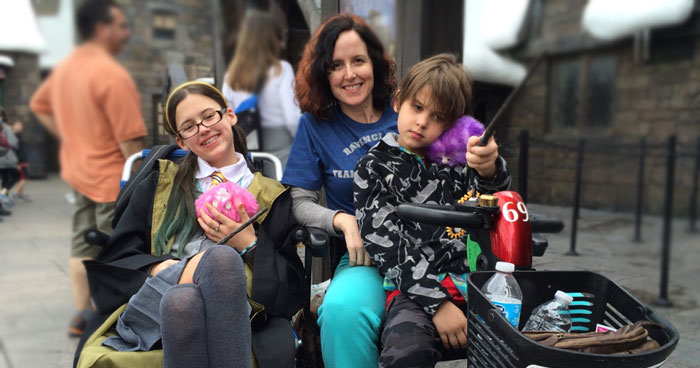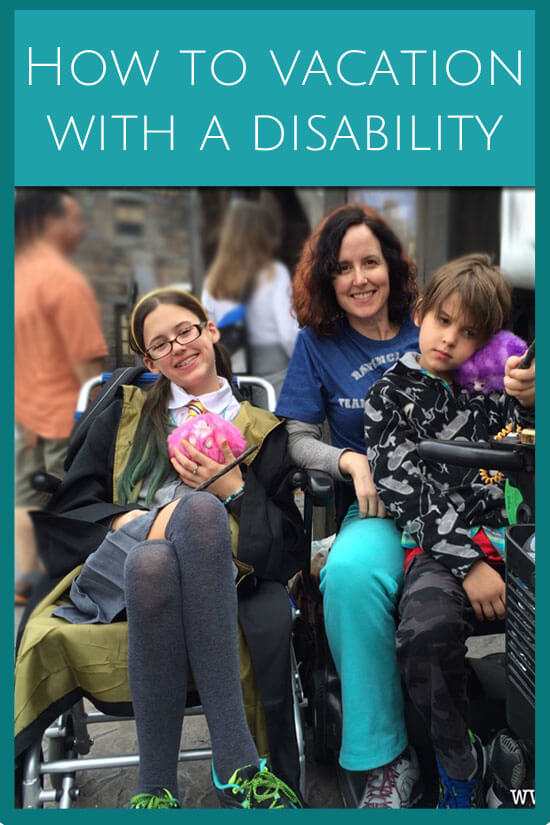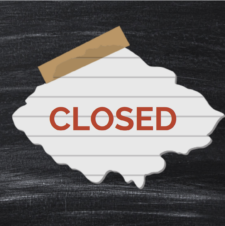How to Vacation With a Disability

We lasted 12 years without taking our kids to Orlando. This was finally our year to make the time and financial investment to bring them to Universal Studios and Disney World. However, three out of four of us have Ehlers-Danlos Syndrome (EDS): I didn’t know how to vacation with a disability. Was this kind of a trip even possible for us?
Yes, it is.
I did a lot of research, made some good guesses, and a few mistakes. I started out by searching for blogs on “how to vacation with a disability” or “traveling with a handicap,” and was shocked when I came up empty-handed. I figured I would have to use my skills to navigate these waters, as I have been bushwhacking my way through our EDS diagnosis for the past four years. I’m going to show you how to vacation with a disability (or at least, how we did it.)
The biggest hurdle was going to be ambulation: we can’t walk long distances. I reached out to friends I met at the EDNF Conference to ask how they managed and learned about this awesome travel wheelchair. It is so light; it can be carried on an able-bodied shoulder and put on the oversized luggage carousel on the plane. A few things to note:
- It won’t go on the same carousel as your other bags; keep that in mind when going to baggage claim.
- Have the airline personnel put a fragile sticker on the wheelchair.
- Cut an old credit card in half, wrap several feet of Gorilla Tape or Duck Tape around it, and slip it in the chair’s carrying case. The bag is fragile, and it tears easily. The tape is a great fix in a jam.
- The chair has nuts and bolts that can come loose in the middle of your trip, so carry the small tool set it comes with at all times. We had no such problem with it, but our friends did.
However, that was one chair that needs to be pushed by an able-bodied walker, and we have three people who need assistance. I needed to rent a motorized scooter. To rent one from the theme park, a person must be 18 years or older, and only that adult can be on that scooter. So, I couldn’t drive and let my 9-year-old son on, who also needs assistance. I was contemplating my dilemma while on the phone with my travel agent when she restated that I can’t ride one of their scooters and have my son ride it with me, or their security guards will be legally bound to ask him to get off. Hmmm. Do outside companies rent to visitors (yes), and does Universal have the same legal obligation to remove my son? (No.) Bingo! OK, ambulation problem solved.
We chose to stay at a Universal resort that granted us early park admission and express passes for all but the most popular rides. Being right next to the theme park was awesome on the day that my son and I needed to go back, and nap and my daughter and husband wanted to stay and tackle an advanced coaster. I called the hotel the day before we arrived, was reassured that there was space for my scooter outside of my room, and was assigned the room next to the elevator, so we didn’t have to walk long hallways.
We went in January, which is one of the least popular times of the year to go. We didn’t try to do this trip during peak crowds, or during the summer heat. The timing of our trip was essential, because even though the numbers were low, we still found ourselves rolling against the tide most of then time. You would think that people follow the “rules of the road” when they walk down a path, right? Uh, sure: most of them do, but some people’s road rules are the opposite from ours since guests from all around the world come to these parks. Nine times out of ten, the person coming straight at you on the right side of the road is speaking a foreign language. Overall, it was a great vacation, but there were several learning moments along the way.
Lessons Learned #1 – Always Make Plans (But Know the Plans Will Change)
I picked a dreamy, upscale resort called Portofino Bay that looked like Venice, with a heated, beach-style outdoor pool, fully decked spa, etc. I planned every-other-day theme park trips so we could rest and recover in between the long week that we were there. Then due to several unforeseen issues, we had to switch around our park days and ended up getting only one day to recharge. Also, the weather projected to be between to 50s-70s, but it felt freaking cold much of the time we were there. No swimming and children under 18 are not allowed into the indoor spa. A word of advice: make sure your warmest outfit is neutral, like black fleece pants or something. Around the fifth day in a row that I pulled my stained, aqua-colored sweats out (the warmest pants I brought,), I thought my husband was going to divorce me.
Lessons Learned #2 – Ask ALL The Questions
On the day we were scheduled to visit the Magic Kingdom, I didn’t realize that our resort didn’t have a free shuttle over to Disney. (Lots of people had told me that “everyone does,” and I had neglected to actually ask the Portofino if they do. Rookie mistake.) Because of the scooter, we now needed to call an ADA taxi to drive us there (for $100 round trip). I had previously booked a dinner reservation over at Downtown Disney (now known as “Disney Springs”) for early that evening, knowing it would be a long day. The taxi driver said that it might be “very difficult” for the return driver to find us, given that Disney Springs was under a lot of construction. (It was a total mess.) I was sufficiently spooked. When my friend and travel agent, who by this point had been helping me tweak my trip, texted me during the day that she had found a coveted dinner reservation at Chef Mickey, I jumped at the chance and canceled our other booking. My kids had a blast, having never had the chance to get up close and personal with these characters before. But dinner wasn’t until 8:00 pm, and sadly for me, this was all too much, having set out at 7:30 am. I am still only three months post brain surgery, and I was in a full-blown migraine by this point and couldn’t eat. Had our day been better coordinated in advance, this wouldn’t have happened.
Lesson Learned #3 – Your Family is Not Like Everyone Else
I received a lot of great advice from people over the planning months; the thing is, we are very different from a lot of people in some critical ways. For example, people love the dining plan. I was told that if I did the “extended service dining plan” for the days that we were in the park, I would save a lot of money (about 20-30%). However, what I didn’t factor in is that we were staying in a VIP room, with free breakfast, snack, and Happy Hour that served food worthy of dinner. To then eat two full meals and a snack on those theme park days was too much food. We ended up leaving with credit still on our account. (It rolls over from day to day, but not from trip to trip.) That is an area where I could have saved money. So, take people’s advice with a grain of salt when they tell you what you “have to do.” Ask probing follow-up questions about why they liked things. (I didn’t do this enough.)
Lessons Learned #4 – You Will Forget Things
No matter how much I think that I know our bodies by now, and know how to pack all of the “what-ifs,” I still manage to forget at least one or two major things each vacation. This time, I forgot my rescue medication for migraines (a biggie) and laxatives. (Yeah, buckle up, we’re going to talk about it.) It’s important that you remember that when you travel, you are not going to be in your routine. Whether or not you think you have a routine, you do. When you spend long days in an airport, sleeping in a different bed, walking more or less than normal, using a different pillow, eating different food, drinking different water and less of it; all of these factors contribute to the chronic body freaking out a little. For example, when I leave my home, I am more prone to headaches and constipation (which is already a chronic issue for most EDS people.) Eventually, you will get to know yourself and your family’s needs when you are on the road, but in the meantime, try to remember at least the medications you won’t be able to buy at a pharmacy.
Lesson Learned #5 – Two words – Travel Agent
My friend Kristy Durso started helping me about a week before we left. Unfortunately for me, I didn’t meet her until months into my planning. She is an EDS Mom, mother of an EDS kid, an autistic kid, and has food allergies in her family. Booking travel for people with special needs is her super power! When I asked why I didn’t know about her services (or people like her) as I was doing my research, she explained that she can’t promote herself as a “disability travel agent” according to her company policy. She relies on word of mouth, so I happily pass her services on to everyone I know. (Please note, I am not receiving any compensation for telling you about Kristy. I just think she is wonderful, and I wish to God I had known about her a long time ago.) In just one 30 minute period of sitting down with her over coffee, she: bought my Magic Kingdom passes, set up our three Fast Passes, made sure that my reservations were all linked, which, they weren’t and required getting on the phone with Disney, gave me her list of what not to miss in Harry Potter, and answered about 50 questions. Also, she got us the reservation at Chef Mickey the day we were at Disney, and when Storm Jonas was threatening the last day of our trip and forced us to cut it a day short, she was texting me reassuringly that no matter where we were stranded, she would find us a hotel. I was not worried because I knew she had our back, and keeping a chronic Mom out of the Xanax Zone is an invaluable service indeed.
Because we had to switch our last Universal day, I thought we were going to miss our reservation at Mythos, the #1 rated theme park restaurant where I had booked lunch months before for my little Greek Mythology fan. It took Kristy less than five minutes to switch our reservations so we could still go! Next time we travel, I will be using her from the start, and I know that I will be saving myself precious time, energy, money, and more “lessons learned.” All of the issues that I had with overspending on food, misfiring on restaurant reservations and whatnot could have been avoided by using her eagle-eye on my plans. It’s OK, my “lessons learned” are your “wisdom gained.”
ADA-Friendly: So those are some of the things that could have gone better…but what went well? Everything. In spite of what I just told you, this trip was AMAZEBALLS.
First and foremost, the people who work for these parks are trained to interact with all kinds of guests, including people with disabilities and assistive devices. I have to say, when on a scooter in public at home, I feel invisible. When I was at Universal, I felt like a person to all of those employees. (I get kind of choked up about it, actually.) The staff looked us in the eye, talked to us very personably, and remembered our names – it was easy with my daughter in full Hufflepuff uniform – she got a lot of attention! They even made jokes about our wheels, which I LOVED! In Islands of Adventure, an Arabian princess accused us of being in a “chariot race,” claiming that my daughter was winning. And just outside of the Hogsmeade gates is Phineas the Talking Fountain. (Who you have to meet – he is hilarious!) He talked with my kids, had them do a magic trick with their wands, then as we piled onto our wheels and started to roll away, he said, “There they go,” and he played a recording of tires burning rubber and peeling away! I laughed so hard tears came to my eyes. Getting around on the scooter was very easy: all of the resorts, water taxis, monorails, even the Hogwarts Express have the ability to handle you and your assistive device with ease and dignity.
Dealing with Lines: We went to Guest Services on our first day at Universal, and got a “Disability Pass”. This allowed us to get in a special shorter line or to get a return time for any ride with a wait time over 30 minutes, so we didn’t have to stand in a long line. When there was a less than 30-minute wait, we got in a special line and bypassed most of the line to get to elevators through Gringotts and Hogwarts, (though you will miss seeing part of the castle). My son and I would park the scooter in a pram parking section and walk onto a ride, but we would push our daughter in her chair through the line up to the ride, (which was great for me, because the chair acted like a walker). For those of you traveling with young or very disabled family members, Universal has a “child swap”section on their rides, so that you can bring the baby or sibling all the way through with you to the loading dock where one parent can wait while the other one rides, and then swap them out, so that the person doesn’t have to wait in line again. It’s brilliant, and even though it’s right on the Universal website and app, we didn’t figure it out until a few hours into our first day. You’re welcome!
Disney does not have a formal “Disability Pass” as most of their rides are wheelchair user accessible. But I did notice that on a few rides we bypassed some of the line by having the chair. (Having a scooter and a wheelchair never made us wait longer, except for an ADA taxi, so avoid that if you can.) At Space Mountain, we got a “return time” just like we did with the “Disability Pass” at Universal.
Things to Help Make Your Trip a Success:
- Use a travel agent, especially one that understands your family’s unique needs. They know things you don’t know and can help you save money. Also, they can help you in case problems arise (like a freaking record-setting blizzard that cuts your trip short) To reach Kristy Durso, email her at kristy@kingdomkonsultant.com.
- Choose wheelchair user accessible locations and ADA-friendly staff.
- Ask ahead of time about motor scooter rental policy, and choose an outside company if necessary, so theme parks won’t be legally compelled to kick children off your scooter.
- Travel during a non-peak season to minimize crowds. (But we won’t go in January again. It’s too cold.)
- Choose a resort that is close to the park so you can go back and rest if you need to.
- Call before you arrive and ask for a room near the elevator, as well as relay other details about your needs.
- Stay on top of the weather, and pack appropriate, neutral clothes, comfortable shoes, hats, gloves, etc.
- Bring pain control: TENS unit, Kinesiology tape, rescue medication, braces, nausea medication (for 3D rides), etc., and other medications for symptom relief (wink).
- Poll friends who have been to the parks about which rides are “hard on the neck,” so if you have issues like POTS or cervical instability, you know which ones to avoid.
- Drink enough water! You can bring water and food to Universal and Disney parks, which is awesome for people with food allergies.
- Alternate park and recovery days.
- Visit Guest Services to get Disability Access Passes, if applicable, and identify where the First Aid stations are before you start your day.
- Find quiet places to sit and rest during the day. You will see people all over with napping children – everyone is exhausted!
- Pre-book any physical therapy, massage, chiropractic, or other restorative appointments for the immediate days after your return. You are going to need help repairing and recovering.
I hope this post inspires you to plan a trip that you didn’t think was possible.
PIN IT FOR LATER:
Head to the Family Room
This post was syndicated with permission to BonBon Break Media, LLC.





